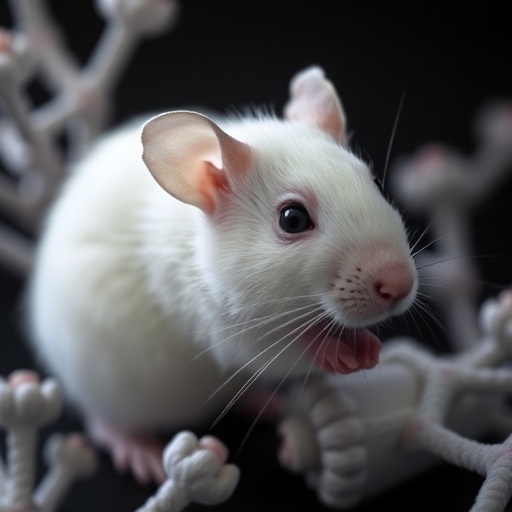In the rapidly evolving field of nanotechnology, researchers continue to unveil the potential impacts of nanoscale materials on biological systems. A recent study led by a team of experts, including Hanif, Khan, and Anwar, has turned significant attention toward molybdenum disulfide (MoS2) nanoflowers. These unique nanostructures exhibit promising characteristics that could revolutionize various applications, including drug delivery, biosensing, and even tissue engineering. However, their interaction with biological systems necessitates thorough examination to understand both their therapeutic potential and any associated risks.
The study, published in the esteemed journal BMC Pharmacology and Toxicology, meticulously investigates the acute, sub-acute, and developmental toxicity associated with the introduction of molybdenum disulfide nanoflowers into biological systems—in this case, using rat models as subjects. Following internationally recognized guidelines set forth by the Organisation for Economic Co-operation and Development (OECD), the researchers conducted a series of thorough experiments to evaluate potential toxicological effects. These studies are crucial as they provide fundamental insights into the safety and efficacy of newly developed nanomaterials.
To comprehend the methodologies employed in the study, it is essential to understand how nanoflowers are synthesized. The researchers utilized a hydrothermal method to create the MoS2 nanoflowers, leveraging their unique structure to maximize surface area and reactivity. This innovative approach resulted in the formation of complex, flower-like shapes that can significantly enhance interactions with biological entities. By employing advanced characterization techniques, the team confirmed the morphology and structural integrity of the synthesized nanostructures, a vital step in establishing a baseline for toxicity testing.
The acute toxicity phase of the study involved administering varying doses of MoS2 nanoflowers to rats over a short period. Researchers closely monitored the animals for any immediate adverse effects, including behavioral changes, physiological responses, and mortality rates. Such rigorous assessments are vital in determining a safe dose range and understanding the short-term implications of exposure to these nanomaterials. The outcomes of this phase revealed important patterns regarding dose-dependency and biological responses.
Following the acute assessment, the study progressed to the sub-acute toxicity evaluations, where the researchers administered nanoflowers over a more extended time frame. This phase aimed to elucidate not only the potential accumulation of MoS2 within the body but also its effects on vital organs over days and weeks. By measuring various biomarkers in the blood and performing histopathological examinations of organ tissues, the researchers obtained comprehensive data that depict the long-term implications of exposure. Through meticulous data analysis, they could draw correlations between exposure levels and resultant organ health, which is paramount for risk assessment.
One particularly remarkable aspect of the study is its exploration of developmental toxicity. Investigating the effects of molybdenum disulfide nanoflowers on the offspring of exposed rats adds a layer of complexity to the research. By assessing the health and development of the pups born to mothers administered with nanoflowers, the researchers aimed to provide a clearer understanding of transgenerational effects. These findings could prove crucial for understanding the broader ecological implications of using nanomaterials in consumer products.
The data derived from these studies not only highlights potential risks but also broaches essential dialogues surrounding regulatory practices in nanotechnology. The OECD guidelines serve to standardize testing procedures, but as the landscape of nanotechnology shifts, so too must the frameworks that govern their safe usage. The results from this research may help bridge the gap between scientific innovation and regulatory policies aimed at ensuring human and environmental health.
The study’s findings indicate that while molybdenum disulfide nanoflowers hold significant promise for advancing technology, their safety profile requires careful consideration. Preliminary observations suggest that specific exposure levels may trigger adverse biological responses, underscoring the critical need for further investigations. Continued research is necessary to comprehensively evaluate the long-term consequences of exposure and any potential mitigation strategies that can be employed.
Moreover, the implications of this research extend far beyond the immediate results of the toxicity assessments. As industries increasingly embrace nanotechnology, understanding the biological interactions of these materials is vital to safeguard public health and the environment. The insights garnered from this study could catalyze further investigations, fostering an era of responsible innovation within the field.
The authors call for improved collaboration between scientists, regulators, and industry stakeholders to ensure that developments in nanotechnology do not outpace safety measures. By prioritizing research focused on toxicity and developing robust regulatory frameworks based on robust scientific evidence, we can contribute to responsible technological advancements that uphold health and safety standards.
In conclusion, this groundbreaking study on the acute, sub-acute, and developmental toxicity of molybdenum disulfide nanoflowers provides a thorough investigation into a promising area of nanotechnology. Through rigorous experimentation and adherence to established guidelines, the research team successfully exposed potential risks associated with these materials. As the landscape of nanotechnology continues to evolve, ongoing collaboration and research will be crucial in ensuring that innovation aligns with our commitment to health and safety.
As we navigate the complexities of this new frontier, the balance between harnessing the potential of nanotechnology and mitigating associated risks will be imperative. It is through studies like these that we can build a safer, more informed future surrounding the utilization of innovative materials in various applications.
Subject of Research: Toxicity studies of molybdenum disulfide nanoflowers in biological systems.
Article Title: Acute, sub-acute and developmental toxicity studies of molybdenum disulfide nanoflowers in rats, as per OECD guidelines.
Article References: Hanif, F., Khan, A., Anwar, F. et al. Acute, sub-acute and developmental toxicity studies of molybdenum disulfide nanoflowers in rats, as per OECD guidelines. BMC Pharmacol Toxicol 26, 153 (2025). https://doi.org/10.1186/s40360-025-00881-8
Image Credits: AI Generated
DOI:
Keywords: Molybdenum disulfide, nanoflowers, toxicity studies, acute toxicity, sub-acute toxicity, developmental toxicity, OECD guidelines, nanotechnology.




